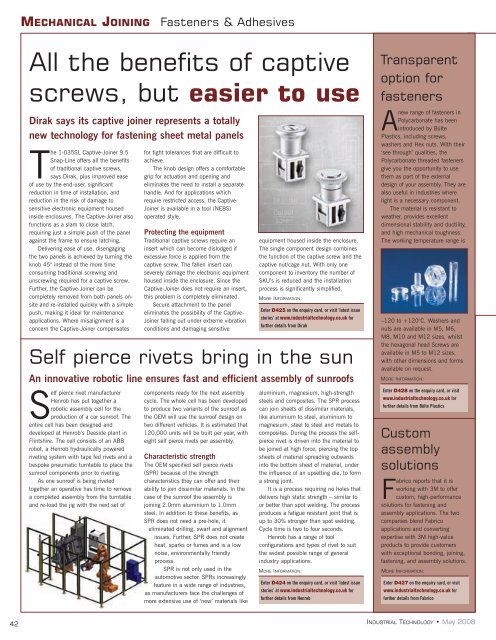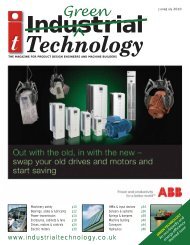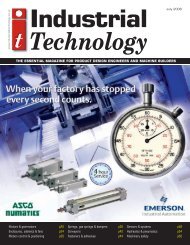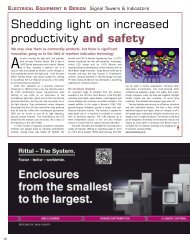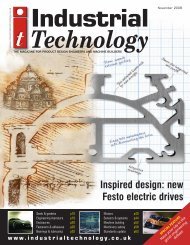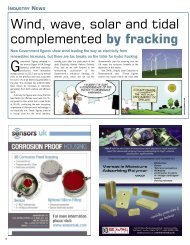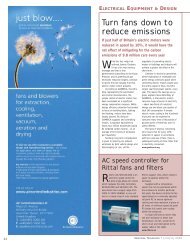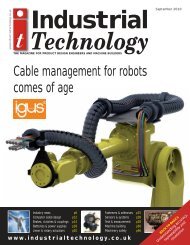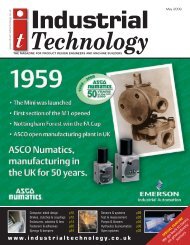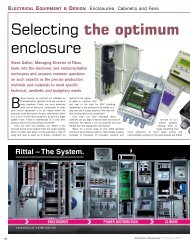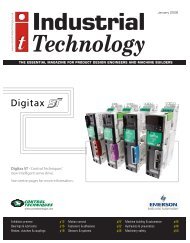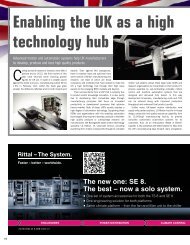sensors & systems - Industrial Technology Magazine
sensors & systems - Industrial Technology Magazine
sensors & systems - Industrial Technology Magazine
You also want an ePaper? Increase the reach of your titles
YUMPU automatically turns print PDFs into web optimized ePapers that Google loves.
MECHANICAL JOINING<br />
Fasteners & Adhesives<br />
All the benefits of captive<br />
screws, but easier to use<br />
Dirak says its captive joiner represents a totally<br />
new technology for fastening sheet metal panels<br />
The 1-035SL Captive-Joiner 9.5<br />
Snap-Line offers all the benefits<br />
of traditional captive screws,<br />
says Dirak, plus improved ease<br />
of use by the end-user, significant<br />
reduction in time of installation, and<br />
reduction in the risk of damage to<br />
sensitive electronic equipment housed<br />
inside enclosures. The Captive-Joiner also<br />
functions as a slam to close latch,<br />
requiring just a simple push of the panel<br />
against the frame to ensure latching.<br />
Delivering ease of use, disengaging<br />
the two panels is achieved by turning the<br />
knob 45° instead of the more time<br />
consuming traditional screwing and<br />
unscrewing required for a captive screw.<br />
Further, the Captive-Joiner can be<br />
completely removed from both panels onsite<br />
and re-installed quickly with a simple<br />
push, making it ideal for maintenance<br />
applications. Where misalignment is a<br />
concern the Captive-Joiner compensates<br />
for tight tolerances that are difficult to<br />
achieve.<br />
The knob design offers a comfortable<br />
grip for actuation and opening and<br />
eliminates the need to install a separate<br />
handle. And for applications which<br />
require restricted access, the Captive-<br />
Joiner is available in a tool (NEBS)<br />
operated style.<br />
Protecting the equipment<br />
Traditional captive screws require an<br />
insert which can become dislodged if<br />
excessive force is applied from the<br />
captive screw. The fallen insert can<br />
severely damage the electronic equipment<br />
housed inside the enclosure. Since the<br />
Captive-Joiner does not require an insert,<br />
this problem is completely eliminated.<br />
Secure attachment to the panel<br />
eliminates the possibility of the Captive-<br />
Joiner falling out under extreme vibration<br />
conditions and damaging sensitive<br />
equipment housed inside the enclosure.<br />
The single component design combines<br />
the function of the captive screw and the<br />
captive nut/cage nut. With only one<br />
component to inventory the number of<br />
SKU’s is reduced and the installation<br />
process is significantly simplified.<br />
MORE INFORMATION:<br />
Enter D425 on the enquiry card, or visit ‘latest issue<br />
stories’ at www.industrialtechnology.co.uk for<br />
further details from Dirak<br />
Self pierce rivets bring in the sun<br />
An innovative robotic line ensures fast and efficient assembly of sunroofs<br />
Self pierce rivet manufacturer<br />
Henrob has put together a<br />
robotic assembly cell for the<br />
production of a car sunroof. The<br />
entire cell has been designed and<br />
developed at Henrob’s Deeside plant in<br />
Flintshire. The cell consists of an ABB<br />
robot, a Henrob hydraulically powered<br />
riveting system with tape fed rivets and a<br />
bespoke pneumatic turntable to place the<br />
sunroof components prior to riveting.<br />
As one sunroof is being riveted<br />
together an operative has time to remove<br />
a completed assembly from the turntable<br />
and re-load the jig with the next set of<br />
components ready for the next assembly<br />
cycle. The whole cell has been developed<br />
to produce two variants of the sunroof as<br />
the OEM will use the sunroof design on<br />
two different vehicles. It is estimated that<br />
120,000 units will be built per year, with<br />
eight self pierce rivets per assembly.<br />
Characteristic strength<br />
The OEM specified self pierce rivets<br />
(SPR) because of the strength<br />
characteristics they can offer and their<br />
ability to join dissimilar materials. In the<br />
case of the sunroof the assembly is<br />
joining 2.0mm aluminium to 1.0mm<br />
steel. In addition to these benefits, as<br />
SPR does not need a pre-hole, it<br />
eliminated drilling, swarf and alignment<br />
issues. Further, SPR does not create<br />
heat, sparks or fumes and is a low<br />
noise, environmentally friendly<br />
process.<br />
SPR is not only used in the<br />
automotive sector. SPRs increasingly<br />
feature in a wide range of industries,<br />
as manufacturers face the challenges of<br />
more extensive use of ‘new’ materials like<br />
aluminium, magnesium, high-strength<br />
steels and composites. The SPR process<br />
can join sheets of dissimilar materials,<br />
like aluminium to steel, aluminium to<br />
magnesium, steel to steel and metals to<br />
composites. During the process the selfpierce<br />
rivet is driven into the material to<br />
be joined at high force, piercing the top<br />
sheets of material spreading outwards<br />
into the bottom sheet of material, under<br />
the influence of an upsetting die, to form<br />
a strong joint.<br />
It is a process requiring no holes that<br />
delivers high static strength – similar to<br />
or better than spot welding. The process<br />
produces a fatigue resistant joint that is<br />
up to 30% stronger than spot welding.<br />
Cycle time is two to four seconds.<br />
Henrob has a range of tool<br />
configurations and types of rivet to suit<br />
the widest possible range of general<br />
industry applications.<br />
MORE INFORMATION:<br />
Enter D424 on the enquiry card, or visit ‘latest issue<br />
stories’ at www.industrialtechnology.co.uk for<br />
further details from Henrob<br />
Transparent<br />
option for<br />
fasteners<br />
Anew range of fasteners in<br />
Polycarbonate has been<br />
introduced by Bülte<br />
Plastics, including screws,<br />
washers and Hex nuts. With their<br />
‘see through’ qualities, the<br />
Polycarbonate threaded fasteners<br />
give you the opportunity to use<br />
them as part of the external<br />
design of your assembly. They are<br />
also useful in industries where<br />
light is a necessary component.<br />
The material is resistant to<br />
weather, provides excellent<br />
dimensional stability and ductility,<br />
and high mechanical toughness.<br />
The working temperature range is<br />
–120 to +120°C. Washers and<br />
nuts are available in M5, M6,<br />
M8, M10 and M12 sizes, whilst<br />
the hexagonal head Screws are<br />
available in M5 to M12 sizes,<br />
with other dimensions and forms<br />
available on request.<br />
MORE INFORMATION:<br />
Enter D428 on the enquiry card, or visit<br />
www.industrialtechnology.co.uk for<br />
further details from Bülte Plastics<br />
Custom<br />
assembly<br />
solutions<br />
Fabrico reports that it is<br />
working with 3M to offer<br />
custom, high-performance<br />
solutions for fastening and<br />
assembly applications. The two<br />
companies blend Fabrico<br />
applications and converting<br />
expertise with 3M high-value<br />
products to provide customers<br />
with exceptional bonding, joining,<br />
fastening, and assembly solutions.<br />
MORE INFORMATION:<br />
Enter D427 on the enquiry card, or visit<br />
www.industrialtechnology.co.uk for<br />
further details from Fabrico<br />
42<br />
INDUSTRIAL TECHNOLOGY • May 2008


